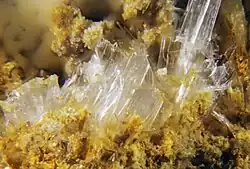Gunningite
| Gunningite | |
|---|---|
 Gunningite | |
| General | |
| Category | Sulfate minerals |
| Formula | (Zn,Mn2+)SO4·H2O |
| IMA symbol | Gun[1] |
| Strunz classification | 7.CB.05 |
| Dana classification | 29.6.2.5 |
| Crystal system | Monoclinic |
| Crystal class | Prismatic (2/m) (same H-M symbol) |
| Space group | C2/c |
| Identification | |
| Color | White to colorless |
| Cleavage | Indistinct |
| Mohs scale hardness | 2.5 |
| Luster | Vitreous |
| Diaphaneity | Translucent |
| Specific gravity | 3.195 |
| Optical properties | Biaxial (+) |
| Refractive index | nα = 1.570 nβ = 1.576 nγ = 1.630 |
| References | [2][3][4] |
Gunningite is one of the minerals in the Kieserite group, with the chemical formula (Zn,Mn2+)SO4·H2O. Its name honours Henry Cecil Gunning (1901–1991) of the Geological Survey of Canada and a professor at the University of British Columbia.[3]
Occurrence
Gunningite is rare. It is found in dry areas of the oxidized portions of sphalerite-bearing deposits. It has been noted in mines in Canada (Yukon Territory, British Columbia and New Brunswick), the United States (Nevada and Arizona), Switzerland (Valais), Greece (Attica) and Germany (Baden-Württemberg).
See also
References
- ^ Warr, L.N. (2021). "IMA–CNMNC approved mineral symbols". Mineralogical Magazine. 85 (3): 291–320. Bibcode:2021MinM...85..291W. doi:10.1180/mgm.2021.43. S2CID 235729616.
- ^ http://rruff.geo.arizona.edu/doclib/hom/gunningite.pdf Handbook of Mineralogy
- ^ a b "Gunningite". mindat.org. Hudson Institute of Mineralogy. Retrieved October 10, 2020.
- ^ http://www.webmineral.com/data/Gunningite.shtml Webmineral data